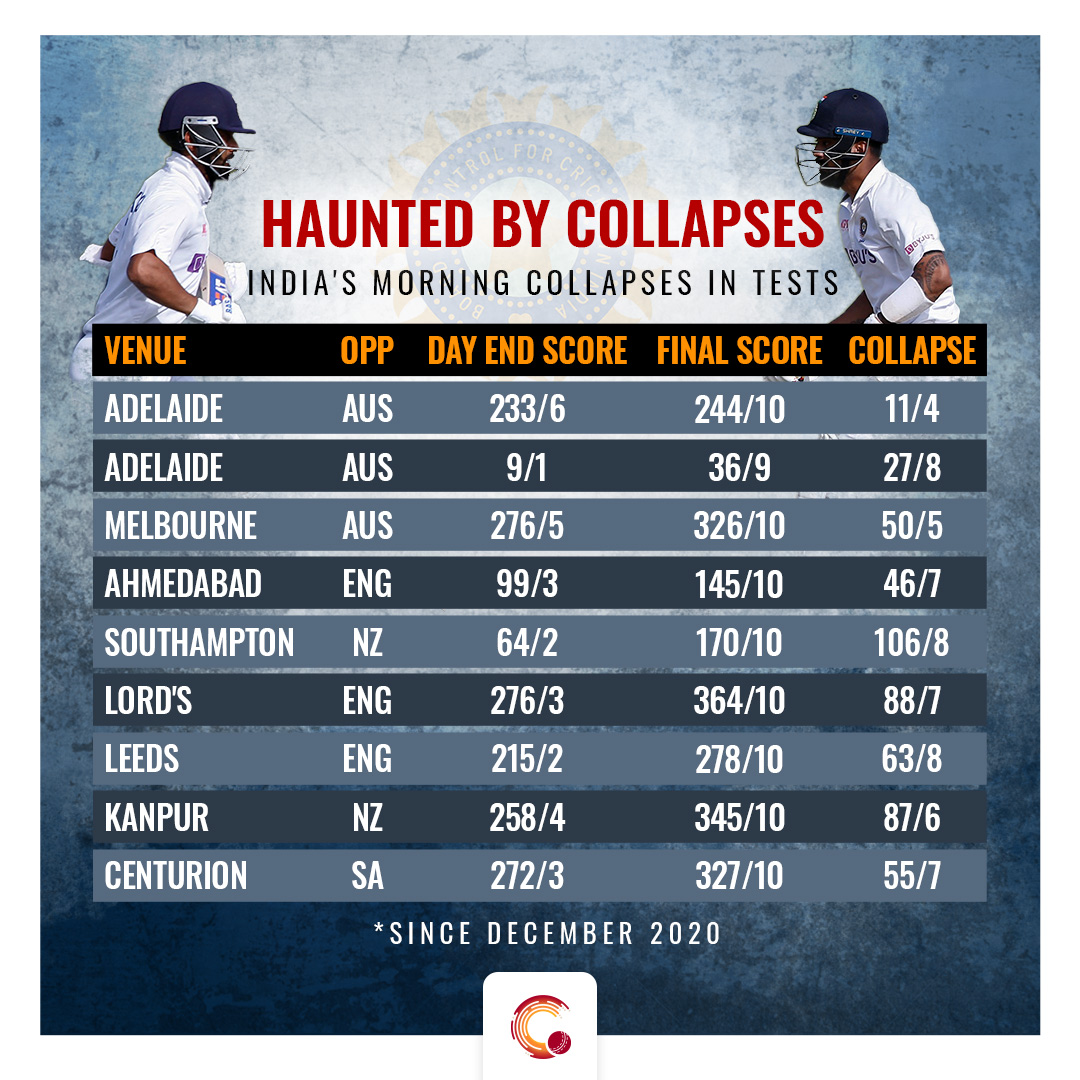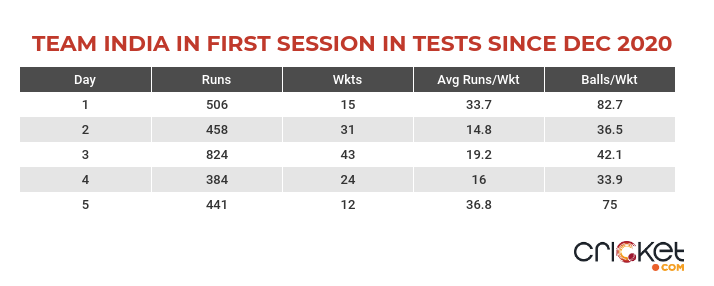 ANALYSIS
ANALYSIS146 runs ahead, India are well and truly in pole position in Centurion. In all likelihood, they will go on to win this first Test should weather permit.
But while the bowling has been firing on all cylinders, the same cannot be said about the batting.
Despite having made gargantuan strides as a side in the past year, team India, somewhere along the way, have picked up a dangerous habit that they simply cannot seem to get rid of.
No matter the venue, no matter the conditions, there seems to be one inevitability: a catastrophic morning collapse that ends up completely undoing the hard work done across hours in the previous day’s play.
Adelaide, Melbourne, Ahmedabad, Southampton, Lord’s, Leeds and Kanpur. Centurion stands as the latest inductee to this list after today.
In a calamitous morning session on Day 3, the side lost 7 wickets for the addition of just 55 runs. In the process, they squandered the opportunity to bat South Africa out of the game for good.
Indeed, the stupendously good showing from the bowlers has ended up mitigating the impact of the early-morning implosion, if not completely neutralising it. And in today’s case, you could give the batters a slight pass too, for most of them were trying to get a move on due to rain taking precious time away from the game by completely washing out the second day’s play.
Still, the fact remains that the side has developed a dangerous pattern over the past 12 months.
Since the start of the Australia tour, quite staggeringly there have been nine instances of the Indian batting suffering catastrophic collapses, some fatal. The 55/7 on Day 3 of Centurion was the latest addition to this rapidly-growing list.
Markedly, all these collapses have come in the very first session of days (post Day 1), often with the side resuming to bat in a strong position.
Today, India resumed to bat on 272/3, with two set batters - Rahul (122*) and Rahane (40*) - out in the middle. Yet 15 overs later the innings was done, with the whole batting unit falling like a pack of cards.
The concern is not just the frequency with which these collapses are happening, but the circumstances too. The side has found a way to get rolled over across conditions, irrespective of the situation of the game.
The collapse today came on the back of a dominant day’s display in which the foundation was laid for the team to post a gigantic first innings total. In the last year alone, there have been three such instances - MCG, Lord’s and Kanpur - where the team has ended up crawling to a par total after being well-placed to post a sizable first innings score. Neither of the previous three instances resulted in defeat, but in every game the collapse kept the opponent in the contest. Absence of ruthlessness.
There have been other wild collapses. Such as the one in Leeds. India resumed Day 4 on 215/2, yet again with two set batters (Pujara 91* and Kohli 45*), still trailing England by 139. Inexplicably, with not a single cloud in sight, they would go on to lose the remaining 8 wickets for just 63 more runs to lose the Test by an innings.
The worst of the lot, though, it has to be said, was the collapse that cost them the World Test Championship final. With multiple days being heavily rain-affected, all India had to do was bat a session and a half to ensure that a loss was taken out of the equation. Again, by Day 6 the conditions had tilted in favour of the batters. But an abject surrender, losing 106/8, would see them hand the title on a platter to the Kiwis.
Surely, then, it cannot be a mere coincidence that all these collapses have occurred in the very first session of days. Since the Australia tour last year, in the first session of Days 2, 3 and 4, India have lost a staggering 98 wickets at 17 apiece, losing a batter every 38 balls. Appalling numbers for any side, let alone for a batting unit that comprises the quality and experience of India.

There can be aberrations, but with India, first-session-collapses - like the one we witnessed today - are becoming the norm.
Clearly, something is not right. Whether it be the preparation or the tactics or, in general, the mindset. For it’s not normal for an elite side to collectively collapse so often so predictably.
The sheer quality of the bowlers has meant that even the most fateful of collapses have, at times, not negatively influenced matches. But if India are eyeing to reach a second World Test Championship final in a row, nothing but ruthlessness would do.
They would already be regretting the points they dropped in Kanpur last month, which was a direct result of their inability to capitalize on a strong first day and bat New Zealand out of the game.
The ‘par’ first-innings total meant that they had to bat 81 overs in the second innings, meaning significant time was taken out of the game. The Kiwis scampered to a draw on the final day, but a more clinical first-innings display could very well have earned India full points.
South Africa are still alive in this first Test, hanging by a thread, but that would never have been the case had the Indian batters, earlier today, spent a couple of hours more and batted the hosts out of the game.
Nine out of ten times you would write off a team that is 146 runs behind, but with India being prone to early-morning implosions, there might be a glimmer of hope for South Africa, yet.
Don’t be surprised if there’s a collapse on the morning of Day 4.